CCTVCam
Known around here
- Sep 25, 2017
- 3,053
- 3,959
Good news, the led warning light works as configured. I could not trigger it to go off by walking down the street or sidewalk anywhere but within my IVS rule. Maybe the factory reset fixed the issue, not sure, but it is working now. I did adjust the exposure compensation down to 9 from 50, as it was a little bright. I did mess with manual trying different shutter speeds and gain but never did see it much better than auto in my case. The led light did wash out my face when I got right in front of cam.
You need a much faster shutter as well. Lots of motion blur. I never use below 6ms & prefer 4ms with light present. That may also assist with the washing out close to the cam as it will lower the brightness, but not the under exposure further away that may beomce darker than you'd prefer.
I was expecting with the new dynamic range to see a much more evenly lit video and with the increased sensitivity, more brightness on the patio steps / area especially given you don't seem to have such a fast shutter set - I'm guesing around 12ms from the blur. Maybe though they're trying to maintain some realism rather than a flat picture. I have to hold my hands up that I'd probably be complaining if it was flat! The problem with the blur is recognition is limited and still shots will be poor. I hope this is just down to settings because otherwise I'm not sure there's any real advancement here. The 4Kt for it's all it's failings still seems to kill it at night. Once the LED's come on, the patio is better lit but the background area becomes under exposed as the camera seems unable to maintain the dynamic range. Less of a concern if all the perps are in the foreground, althougth that's something not guaranteed to happen.
These are the stills I could pull from the video -in the 1st one you're a fuzzy blur like from a cheap brand camera but the grass around is reasonably sharp (?) suggesting it's not likely much of a depth of field or focus issue but most likely shutter. This surprises me slightly as the camera probably has the aperture wide open at this point. That said smaller sensor... Looking at the grass you probably wouldn't be perfectly sharp off the patio, but there'd be a usable image if the shutter issue wasn't present. I'd reduce shutter to a max of 6ms. This is the stillfrom outside the patio area with the current shutter speed, it's consumer level and pretty useless for recognition highlighting the settings issue:
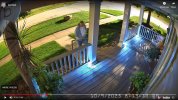
The 2nd one from the patio itself where you aren't washed out, also suggests to me shutter as the main issue :
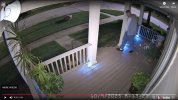
I don't think either shot atm would stand up in Court as evidence. In fairness where you walked up towards the cam you would get a shot, but you can't guarantee someone would walk in that direction. They could be out to steal your chair, the pots or mail in that back corner.
BTW you mention Exposure Compensation. Be aware, this isn't a magic setting. I believe it's adjusting brightness, contrast & maybe gain behind the scenes to make the picture brighter. So the result you're seeing may be different to the settings you actually set. So beware you may gain a brighter image at detriment to other parameters.


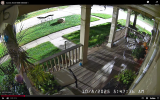
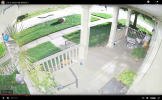
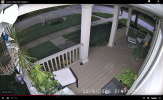
 - Image looking pretty good elsewhere though.
- Image looking pretty good elsewhere though.
